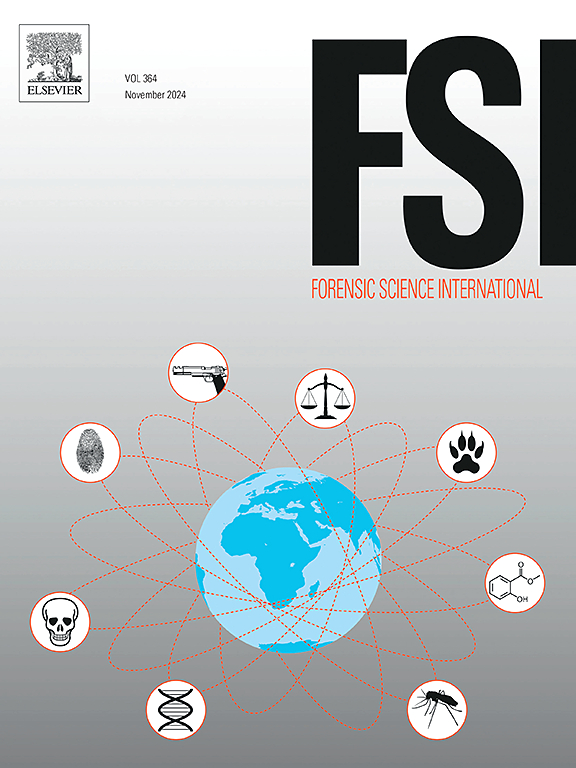Indoor domestic canine scavenging: A literature review
IF 2.2
3区 医学
Q1 MEDICINE, LEGAL
引用次数: 0
Abstract
Scavenging occurs whenever a body is accessible to animals which depredate post-mortem, leading to tissue modification and consumption. In forensic investigations, the consequences of indoor scavenging are associated with the capacity of dogs to destroy or scatter body parts, creating post-mortem artefacts that pose challenges for forensic pathologists and veterinarians in determining the cause and dynamics of death and the time of death estimation. The purpose of this study is to provide a literature review on the forensic implications of indoor domestic dog scavenging, in order to discuss victim and dog characteristics, injury patterns, and identification methods. The literature search was performed using PubMed, Scopus and Web of Science from January 1950 to March 2024. Eligible studies have investigated issues of interest (forensic veterinary medicine, forensic pathology, forensic genetics). A total of 38 studies met the inclusion criteria and were included in the review and they were organized and discussed by issue of interest (Victim risk factors, assessment of canine behavioral and physical conditions, anatomical distribution of post-mortem injuries, assessment of ante-mortem injuries and setting, identification of scavenging dog). The findings of this systematic review underscore the importance of paying particular attention to the condition of the individuals involved, especially isolated elderly individuals, as well as to the results of physical examinations and autopsies. These may provide crucial information regarding the distribution and vitality of lesions. Additionally, the potential benefits of a multidisciplinary approach are emphasized, based on close cooperation between veterinarians, crime scene personnel, medicolegal experts, and prosecutors.
家犬室内食腐:文献回顾。
腐食发生在任何动物可以接触到尸体的时候,这些动物会在尸体死后进行掠夺,导致组织改变和消耗。在法医调查中,室内食腐的后果与狗破坏或散布身体部位的能力有关,造成死后的假象,这对法医病理学家和兽医在确定死亡原因和动态以及估计死亡时间方面构成挑战。本研究的目的是对室内家狗食腐的法医意义进行文献综述,以讨论受害者和狗的特征,伤害模式和鉴定方法。从1950年1月到2024年3月,使用PubMed、Scopus和Web of Science进行文献检索。合格的研究调查了感兴趣的问题(法医兽医、法医病理学、法医遗传学)。共有38项研究符合纳入标准并被纳入本综述,并根据感兴趣的问题(受害者危险因素、犬类行为和身体状况评估、死后损伤的解剖分布、死前损伤评估和设置、食腐犬的鉴定)对其进行组织和讨论。这项系统审查的结果强调了特别注意有关个人,特别是孤立的老年人的状况以及身体检查和尸检结果的重要性。这些可能提供有关病变分布和活力的重要信息。此外,在兽医、犯罪现场人员、法医专家和检察官之间密切合作的基础上,强调了多学科方法的潜在好处。
本文章由计算机程序翻译,如有差异,请以英文原文为准。
求助全文
约1分钟内获得全文
求助全文
来源期刊

Forensic science international
医学-医学:法
CiteScore
5.00
自引率
9.10%
发文量
285
审稿时长
49 days
期刊介绍:
Forensic Science International is the flagship journal in the prestigious Forensic Science International family, publishing the most innovative, cutting-edge, and influential contributions across the forensic sciences. Fields include: forensic pathology and histochemistry, chemistry, biochemistry and toxicology, biology, serology, odontology, psychiatry, anthropology, digital forensics, the physical sciences, firearms, and document examination, as well as investigations of value to public health in its broadest sense, and the important marginal area where science and medicine interact with the law.
The journal publishes:
Case Reports
Commentaries
Letters to the Editor
Original Research Papers (Regular Papers)
Rapid Communications
Review Articles
Technical Notes.
 求助内容:
求助内容: 应助结果提醒方式:
应助结果提醒方式:


